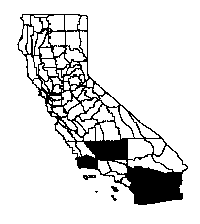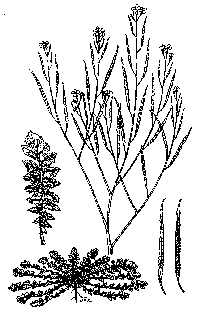| Brassica tournefortii | |||||
| Scientific name | Brassica tournefortii |
||||
|
Additional name information: |
Gouan |
||||
|
Common name |
Sahara mustard, Asian mustard |
||||
|
Synonymous scientific names |
none known |
||||
|
Closely related California natives |
0 |
||||
|
Closely related California non-natives: |
8 |
||||
|
Listed |
CalEPPC List A-2,CDFA nl |
||||
|
By: |
Andrew Sanders,Richard Minnich |
||||
|
Distribution |
|
||||
|
HOW DO I RECOGNIZE IT? |
Sahara mustard (Brassica tournefortii) is an annual herb |
||||
|
Description: |
|
||||
|
WHERE WOULD I FIND IT? |
Sahara mustard is an abundant annual weed at low elevations Apparently uncommon at mid-century, this plant attracted little Now abundant in the Coachella, Borrego, and Imperial valleys of Sahara mustard is most common in wind-blown sand deposits and in |
||||
|
WHERE DID IT COME FROM AND HOW IS IT SPREAD? |
Sahara mustard is native to semi-arid and arid deserts of North During rains, a sticky gel forms over the seed case that permits |
||||
|
WHAT PROBLEMS DOES IT CAUSE? |
Dense stands in the Coachella and Imperial valleys appear to Sahara mustard increases fuel loads and fire hazard in desert |
||||
|
HOW DOES IT GROW AND REPRODUCE? |
set seed by February. Most plants are in fruit or dead by April. Time of flowering probably is controlled by the onset of the rainy season. Early flowering may be triggered by hot spells during winter. During warm or dry winters, plants mature at a small size, ripen seeds, and perish by February. Sahara mustard appears to be self-compatible or autogamous, as there is virtually 100 percent fruit set on most plants. A well developed plant produces between 750 and 9,000 seeds. Seed longevity is unknown, but based on observations of other species of Brassica, it is probably several years. There is little evidence of herbivory or seed parasitism. Sahara mustard may be the most rapidly developing annual in the winter and spring flora of southern California. Once soils have chilled in fall, rains as small as 1.5 in (4 cm) cause mass germination. The period of most rapid growth is from the first winter rains or February to April. Within two to three months, plants can grow to a biomass of 3.0 tons/ha-1, but usually less than 0.5 tons/ha-1. Total biomass does not correlate with annual precipitation because hot, dry spells frequently cause plants to reach premature flowering and fruiting in early winter. Abundance in the Sonoran Desert is sensitive to rainfall. Sahara mustard was found throughout the Sonoran Desert from the Coachella Valley to the Colorado River after heavy (300 percent of normal) rains during the winter of 1991-92. It was virtually absent in the same region after the dry (less than 25 percent of normal) winters of 1995-96 and 1996-97.
|
||||
|
HOW CAN I GET RID OF IT? |
|||||
|
Physical control: |
Manual methods: Hand pulling might be Prescribed burning: The occurrence of this annual in harsh |
||||
|
Biological control: |
Insects and fungi: Sahara mustard is Grazing: Since Sahara mustard establishes from a seedbank, it is Plant competition: Establishment of dense cover of exotic annual |
||||
|
Chemical control: |
The extremely early development of this |
||||




